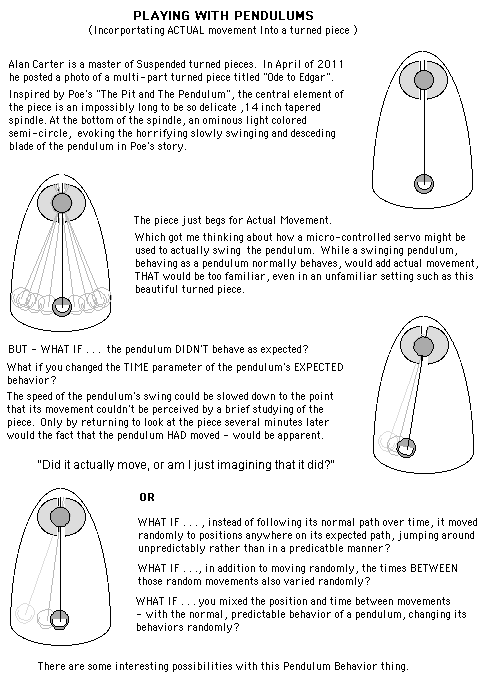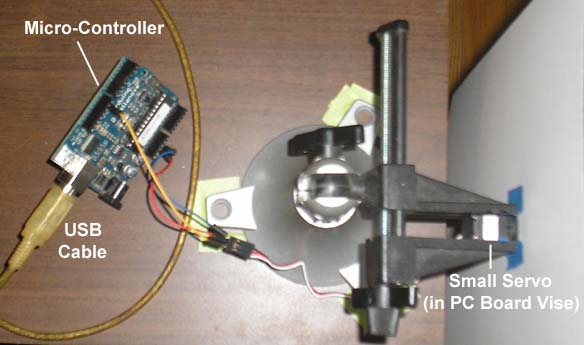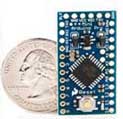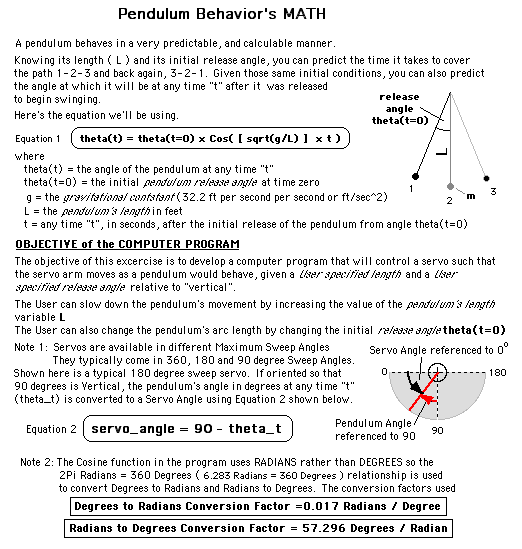PREFACE
If you've read Edgar Allen Poe's "The Pit And The Pendulum", the sight of a swinging pendulum, even in a Grandfather Clock, can cause you to shudder - for just an instant. The thought of being immobilized below a slowly descending pendulum, swinging a sharp blade on its end, is terrifying - the inevitable end to the story horrifying.

I've got several different Arduino battery powered, programmable, micro-controllers, a 9V battery, as well as a small servo that can be operated by a micro-controller. If I knew the physics behind the behavior of a pendulum and the mathematical equations of its behavior - I could write a program to control the servo's "arm" so that it swung - like a pendulum.
Hmmmm . . .
So off to Wikipedia to find the mathematical equations I could program into an Arduino - and have it move a servo's arm so it swings like a pendulum actually does.
With the math I needed it was time to break out a micro-controller, a USB cable to connect it to my Mac Mini, a little $8 servo with a 180 degree "sweep" and some jumper wires to connect pins on the micro-controller to the wire harness of the servo..

NOTE: The micro-controller shown above is only used for prototypind and debugging the program that will drive the servo to swing - like a pendulum. The ACTUAL micro-controller I'll use is considerably smaller. Here's the one that will be used for the actual application.

So the hardware for this idea is $20 for the micro-controller, $8 for the servo and a couple of bucks for a 9V battery - $30 total - to play with MOVEMENT.
To see the Pendulum Behavior in action - with different User Parameter values CLICK HERE
(For more info about Arduino micro-controllers and their use CLICK HERE)
The program that the Arduino uses for this pendulum behavior canbe cut and pasted can be found by CLICKING HERE .
I've included lots of comments to help you understand what the program code does. If you have questions about it feel free to E-mail Me
This was a fun exercise. I spent probably 10 hours on it and another hour or so doing this write up and taking and editiing videos of it in action under different User specified variable values.
So what did I, and perhaps you, get out of all this?
If we slow time WAY DOWN, something that is, in fact moving, albeit VERY S L O W L Y, appear to be static - NOT moving. Think "glaciers".
If we speed time WAY UP, things that are, in fact moving, albeit VERY QUICKLY - like something rotating - or swinging like a pendulum - CAN appear to NOT be moving. Think of waving your hand in a strobe light.
In the Edgar Allen Poe's short story The Pit and the Pendulum, the the sharp curved blade on the end of the swinging pendulum is rightfully perceived as dangerous. The fact that it is slowly descending - towards The Victim - strapped helplessly to a table directly below it - is disconcerting becasue the outcome is soon grasped. The fact that the pendulum swings and descends slowly prolongs the horror of the scene. Will the victim manage to escape his constraints and escape from the swinging blade descending towards him? You are COMPELLED to keep reading.
But how would we perceive the scene - if the blade were only swingingabove the victim - but not descending? Still scary? Yes. The blade might fall off the end of the pendulum - and hit the victim. Scary, but not horrifying. If the blade were swinging FAST, that possibility becomes more likely - and the SCARY goes up - and a little HORROR is added.
What if - the blade wasn't swinging over the victim below - but merely off to one side - while descending? Again, there's the possibility that the mechanism might fail - and the blade might fall onto the victim. Again, still scary - but not horrifying.
What if the blade's not swinging over the victim, but descending in jerking short falls? Might the jerky sudden stops cause the pendulum to snap - and drop the sharp blade on the victim?
Time plays a key role in Poe's The Pit And The Pendulum. Change TIME significantly and the story's impact can be changed.
CONCLUSION:
How and what we peprceive - what we experience - can be significantly affected by how long "time" takes. Being able to manipulate an EXPECTED behavior, and thus the viewer's experience with a piece has some interesting possibilities.
